Development of Large-Scale Tight Gas Sandstone Reservoirs and Recommendations for Stable Production—The Example of the Sulige Gas Field in the Ordos Basin
Abstract
1. Introduction
2. Geological Characteristics
2.1. Tectonic Characteristics
2.2. Matrix Reservoir Characteristics
2.3. Scale Characteristics of Effective Sand Bodies
2.4. Characteristics of Gas–Water Relationship
3. Characteristics and Challenges of Gas Field Development
3.1. Gas Recovery Indices
3.2. Single Well Production Decline Rate
3.3. Dynamically Controlled Reserves of Single Wells
4. Gas Reservoir Development Status and Challenges for Sustainable and Stable Production
4.1. High-Quality Reservoirs
4.2. Comparison of Recovery Indices between New and Old Wells
4.3. The Gas–Water Relationship in the Reserve Replacement Area
4.4. Dense Well Pattern Is an Effective Way to Improve the Recovery of Tight Sandstone Gas Reservoirs
5. Recommendations for Achieving Stable Production
5.1. Dynamic–Static Refined Reservoir Description Technology
5.2. Low-Cost Reserve Utilization Technology
5.3. Reasonable Production Schedule Optimization
5.4. The Negative Pressure Gas Recovery Technology
6. Conclusions
- (1)
- The dominant He-8 member of the Sulige gas field is a braided river sedimentary system, with complex sand body superimpositions in the channels. The effective sand body and petrophysical and gaseous properties of reservoirs have strong non-homogeneity. In some localized areas, the gas–water relationship is complex. There are significant differences in the gas yield, cumulative production, and decline rate between different regions. The gas wells do not have a clear stable production period, and the production declines rapidly in the initial stage.
- (2)
- The average daily production of the production wells in the central, eastern, and western areas of the Sulige gas field in the first 3 years was 11,000 square/day, 96,000 square/day, and 8000 square/day, respectively. The cumulative gas production was 1813.29 million square, 1151.22 million square, and 102.27 million square, respectively. The average decline rates were 15%, 16.9%, and 18.4%, respectively. The comparison of actual production results shows that there are obvious differences in gas well production, cumulative gas production, and decline rate in different regions. There is no obvious stable production period in gas wells, and the initial production decreases rapidly.
- (3)
- Currently, the high-quality reservoirs in the developed regions have a high degree of reserve utilization, and there is a clear trend of worsening and fragmentation of reserves. Moreover, due to the influence of low-quality reserves and inter-well interference, the gas recovery indices of wells put into production in recent years are significantly lower compared with that in the early production stage of the gas field, and the decline rate is higher. In the non-development regions, the quality of reserves is low, and the gas–water relationship is complex, with severe low-yield and fluid accumulation phenomena. It is challenging to improve the recovery factor and achieve effective reserve utilization.
- (4)
- In order to achieve long-term stable production of the Sulige gas field, it is necessary to promote the dynamic–static integrated refined reservoir description technology and improve the degree of reserve utilization via various measures such as replenishing fractures in wells with depleted fractures, sidetracking horizontal wells, and re-fracturing. In addition, negative pressure technology can also be applied as soon as possible to restore the production capacity of near-depletion wells.
Author Contributions
Funding
Institutional Review Board Statement
Informed Consent Statement
Data Availability Statement
Conflicts of Interest
References
- Li, Q.; Zhao, D.; Yin, J.; Zhou, X.; Li, Y.; Chi, P.; Han, Y.; Ansari, U.; Cheng, Y. Sediment Instability Caused by Gas Production from Hydrate-bearing Sediment in Northern South China Sea by Horizontal Wellbore: Evolution and Mechanism. Nat. Resour. Res. 2023, 1–26. [Google Scholar] [CrossRef]
- Zhang, C.P.; Liu, S.; Ma, Z.Y.; Ranjith, P.G. Combined micro-proppant and supercritical carbon dioxide (SC-CO2) fracturing in shale gas reservoirs: A review. Fuel 2021, 305, 121431. [Google Scholar] [CrossRef]
- Sun, L.; Zou, C.; Jia, A.; Wei, Y.; Zhu, R.; Wu, S.; Guo, Z. Development char-acteristics and orientation of tight oil and gas in China. Min. Alogy Petrol. 2019, 46, 1015–1026. [Google Scholar]
- Zhang, B.; Wang, X.; Zhang, C. Rec-ognition of tight sandstone reservoir characteristics and devel-opment potential of the 2nd member of Xujiahe gas reservoir in Zhongba Gas Field. Reserv. Eval. Dev. 2019, 9, 10–15. [Google Scholar]
- Ji, G.; Jia, A.; Meng, D.; Guo, Z.; Wang, G.; Cheng, L.; Zhao, X. Technical countermeasures of effective development and gas recovery enhancement for large tight Gas Field: A case study of Sulige gas field, Ordos Basin, NW China. Pet. Explor. Dev. 2019, 46, 629–641. [Google Scholar]
- Zou, X. Study on Channel Sand Body Identification of Sulige Gas Field in Ordos Basin. Master’s Thesis, Northwest University, Xi’an, China, 2006. [Google Scholar]
- Li, X.; Zhang, M.; Xie, W. Controlling factors for lithologic gas reservoir and regularity of gas distribution in the upper Paleozoic of Ordos Basin. Acta Pet. Sin. 2009, 30, 168–175. (In Chinese) [Google Scholar]
- Guo, Z.; Jia, A.; Ji, G.; Ning, B.; Wang, G.; Meng, D. Reserve classification and well pattern infilling method of tight sandstone gasfield: A case study of Sulige gasfield. Acta Pet. Sin. 2017, 38, 1299–1309. [Google Scholar]
- Wang, J.; Ren, Z.; Shan, J.; Zhu, Y.J. He 8 and Shan 1 members depositional system research in east of Sulige gas field. Geol. Sci. Technol. Inf. 2011, 30, 41–48. [Google Scholar]
- Meng, D.; Jia, A.; Zhi, G.; Guo, Z.; Jin, S.; Wang, G.; Ji, G.; Cheng, L. Effective sand scale and gas well development index evaluation:A case study of Taiyuan formation in Shenmugas field, Ordos basin, NW China. J. China Univ. Min. Technol. 2019, 47, 1047–1054. [Google Scholar]
- Meng, D.; Jia, A.; Ji, G.; He, D. Water and gas distribution and its controlling factors for large scale tight sand gas fields: A case study of western Sulige gas field, Ordos Basin, NW China. Pet. Explor. Dev. 2016, 43, 607–614. [Google Scholar] [CrossRef]
- He, D.B.; Ji, G.; Jiang, Q.; Cheng, L.; Meng, D.; Wang, G.; Guo, Z.; Cheng, M.H.; Han, J.C. Differential development technological measures for high-water-cut tight sandstone gas reservoirs in western area of Sulige Gas Field. Nat. Gas Ind. 2022, 42, 73–82. [Google Scholar]
- Guo, Q.; Chen, K.; Li, Z. Reasonable calculation method of dynamic reserves for low permeability reservoirs. Spec. Oil Gas Reserv. 2016, 23, 113–115. [Google Scholar]
- Wang, J.; Jia, A.; Wei, Y.; Jia, C.; Qi, Y.; Yuan, H.; Jin, Y. Optimization workflow for stimulation-well spacing design in a multiwell pad. Pet. Explor. Dev. 2019, 46, 1039–1050. [Google Scholar] [CrossRef]
- Li, Y.; Xu, W.; Xiao, F.; Liu, L.; Liu, S.; Zhang, W. Development well pattern optimization based on dynamic characteristics: A case study from the Sulige tight sandstone gas field with great heterogeneity. Nat. Gas Ind. 2014, 34, 56–61. [Google Scholar]
- Lu, T.; Liu, Y.; Wu, L.; Wang, X. Challenges to and countermeasures for the production stabilization of tight sandstone gas reservoirs of the Sulige Gasfield, Ordos Basin. Nat. Gas Ind. 2015, 35, 43–52. [Google Scholar] [CrossRef]
- Yu, S.; Tian, J. Study and application of drainage gas recovery technology in Sulige gas field. Drill. Prod. Technol. 2012, 35, 40–43. [Google Scholar]
- He, W.; Wu, S.; Tang, Y.; Lin, S.Q.; Zhang, B.H. The architecture analysis of the underground point bar: Taking Gudao oilfield as an example. J. Mineral. Petrol. 2005, 25, 81–86. [Google Scholar]
- Qiu, Y.; Jia, A. Development of geological reservoir modeling in past decade. Acta Pet. Sin. 2000, 21, 101–104. [Google Scholar]
- Jia, A. Research achievements on reservoir geological modeling of China in the past two decades. Acta Pet. Sin. 2011, 32, 181–188. [Google Scholar]
- Jia, A.; Wang, G.; Meng, D.; Guo, Z.; Ji, G.; Cheng, L. Well pattern infilling strategy to enhance oil recovery of giant low-permeability tight gasfield: A case study of Sulige gasfield, Ordos Basin. Acta Pet. Sin. 2018, 39, 802–813. [Google Scholar]
- Cheng, M.; Meng, D.; Wang, L.; Jiang, Q.; Wang, G.; Zhao, M. Evaluation of horizontal well differential development effect in tight Sand stone gas reservoir: A case study of Sulige gas field, Ordos Basin. J. China Univ. Min. Technol. 2023, 52, 354–363. [Google Scholar]
- Li, Q.; Gao, S.; Yang, Z.; Feng, Q.; Ye, L. Influence of the threshold pressure gradient on tight sandstone gas reservoir recovery. Nat. Gas Geosci. 2014, 25, 1444–1449. [Google Scholar]
- Zhou, K.M.; Li, N.; Zhang, Q.X.; Tang, X.G. Experimental research on gas-water two phase flow and confined gas formation mechanism. Nat. Gas Ind. 2002, 22, 122–125. [Google Scholar]
- Zhang, C.; Jin, D.; Li, S.; Zhang, J. Progress and measurement of drainage gas recovery technology in Sulige gas field. Nat. Gas Explor. Dev. 2016, 39, 48–52. [Google Scholar]
- Yang, Z.; Kong, L.; Du, M.; Zhao, C. Economic evaluation on tight sandstone gas development projects in China and recommendation on fiscal and taxation support policies. Nat. Gas Ind. 2016, 36, 98–109. [Google Scholar] [CrossRef]
- Li, Y.; Li, K.; Wang, Z.; Wang, H.; Ding, J.; Weili, H. Study on dynamic production optimization for water produced gas wells in Daniudi low permeability gas reservoirs. Oil Drill. Prod. Technol. 2013, 35, 71–74. [Google Scholar]
- Mao, M.; Li, Y.; Wang, H.; Li, J.; Zhao, Z. Prediction of gas well abandonment production in the Sulige gas field. Nat. Gas Ind. 2010, 30, 64–66. [Google Scholar]
- Cheng, M.; Xue, W.; Zhao, M.; Wang, G.; Ning, B.; Ji, G.; Cheng, L.; Tian, Y. Production Data Analysis and Practical Applications in the Sulige Tight Gas Reservoir, Ordos Basin, China. Geofluid 2021, 2021, 10. [Google Scholar] [CrossRef]
- Wang, J.; Zhang, C.; Li, J. Tight sandstone gas reservoirs in the Sulige Gas Field: Development understandings and stable-production proposals. Nat. Gas Ind. 2021, 41, 100–104. [Google Scholar]
- Asghar, Z.; Shatanawi, W.; Shah, R.A.; Gondal, M.A. Impact of viscoelastic ooze slime on complex wavy gliders near a solid boundary. Chin. J. Phys. 2023, 81, 26–36. [Google Scholar] [CrossRef]
- Asghar, Z.; Shah, R.A.; Pasha, A.A.; Rahman, M.M.; Khan, M.W.S. Controlling kinetics of self-propelled rod-like swimmers near multi sinusoidal substrate. Comput. Biol. Med. 2022, 151, 106250. [Google Scholar] [CrossRef] [PubMed]
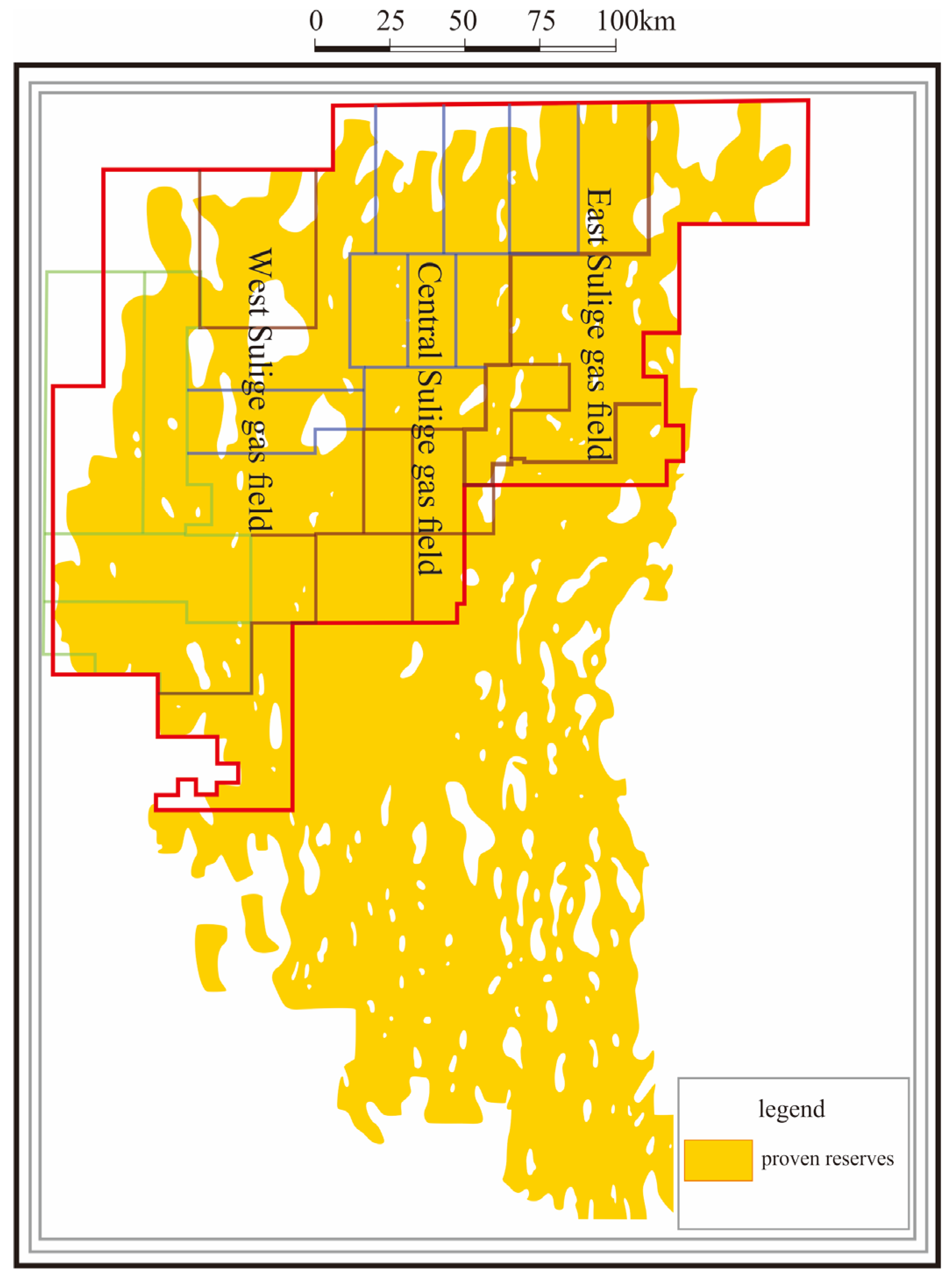
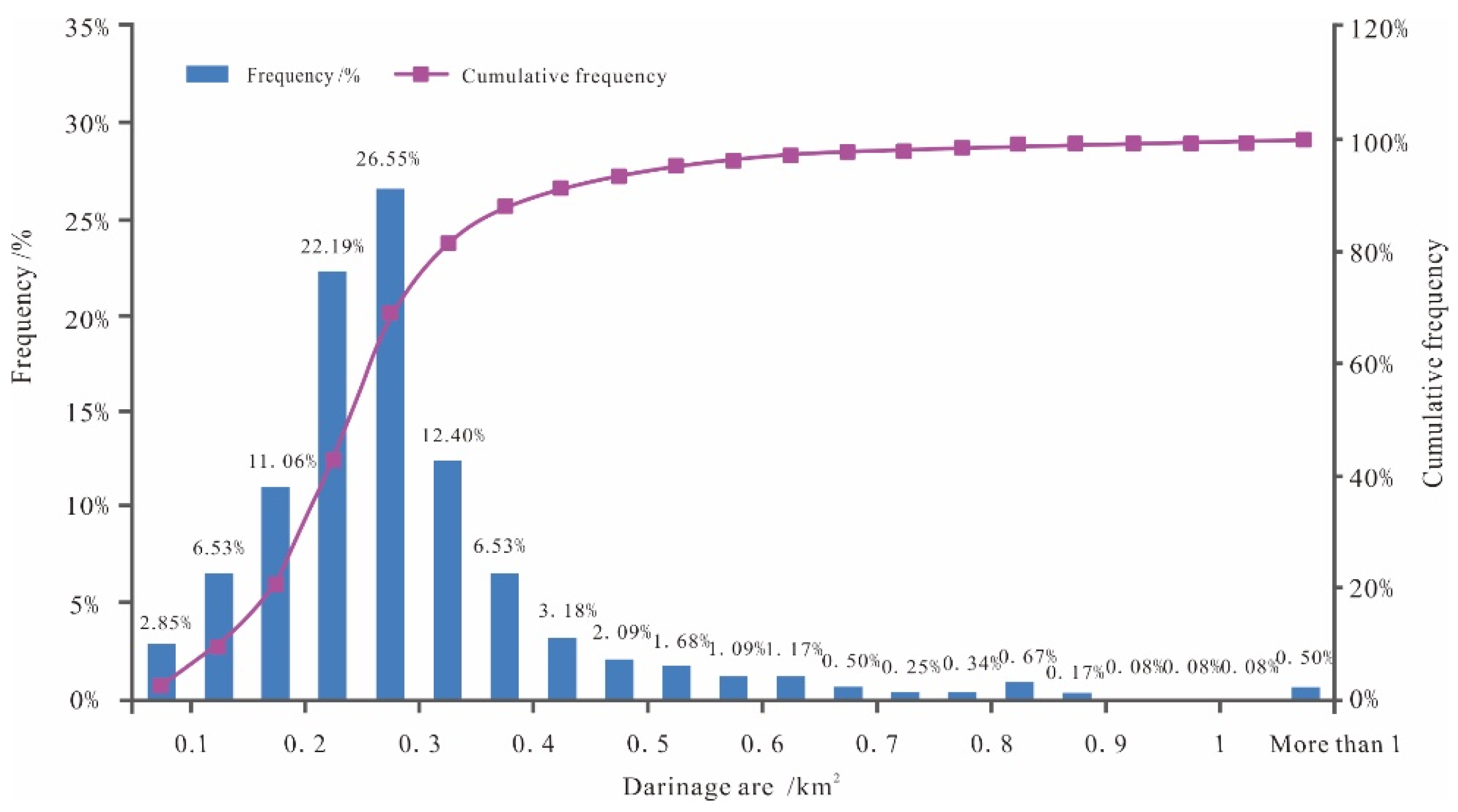
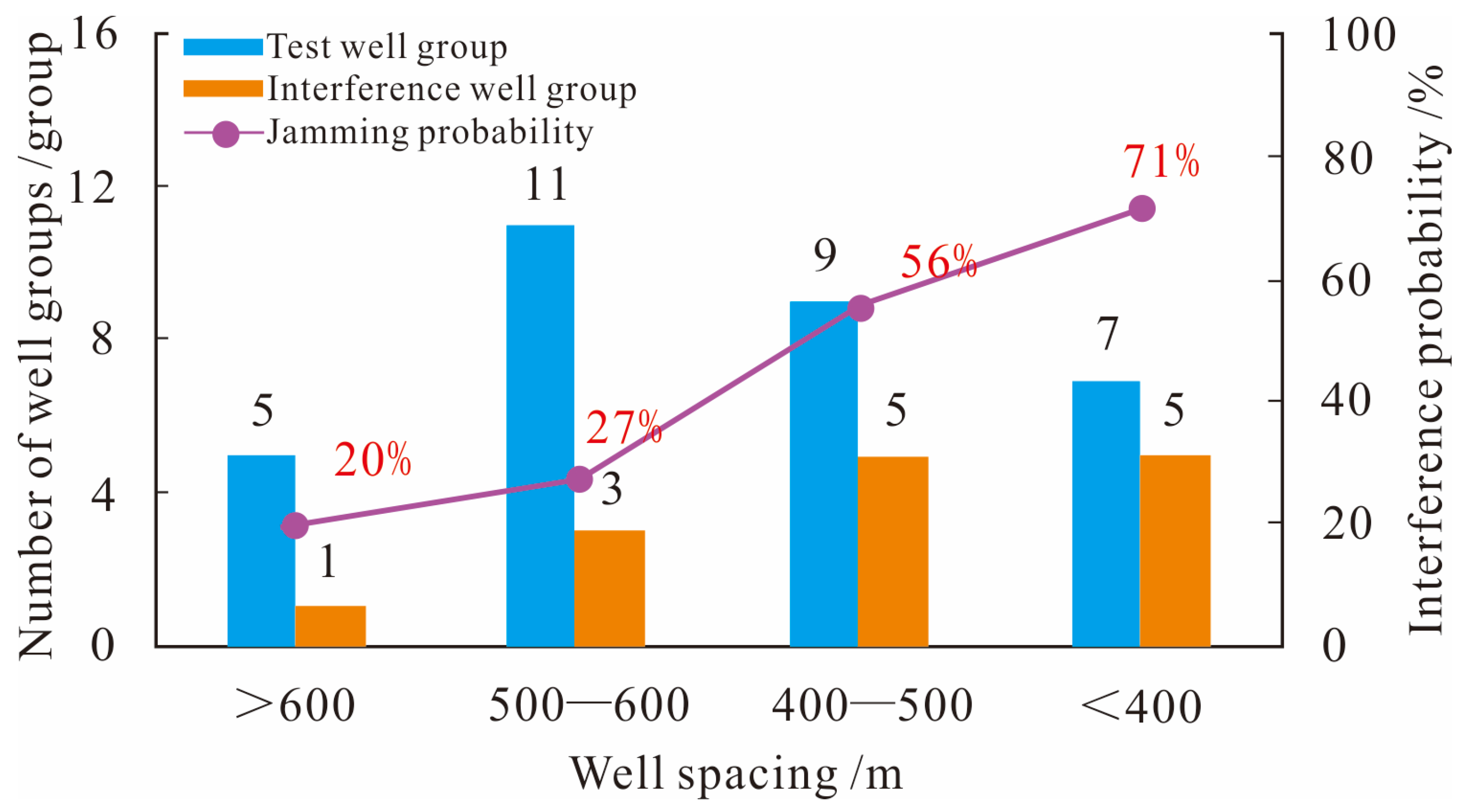
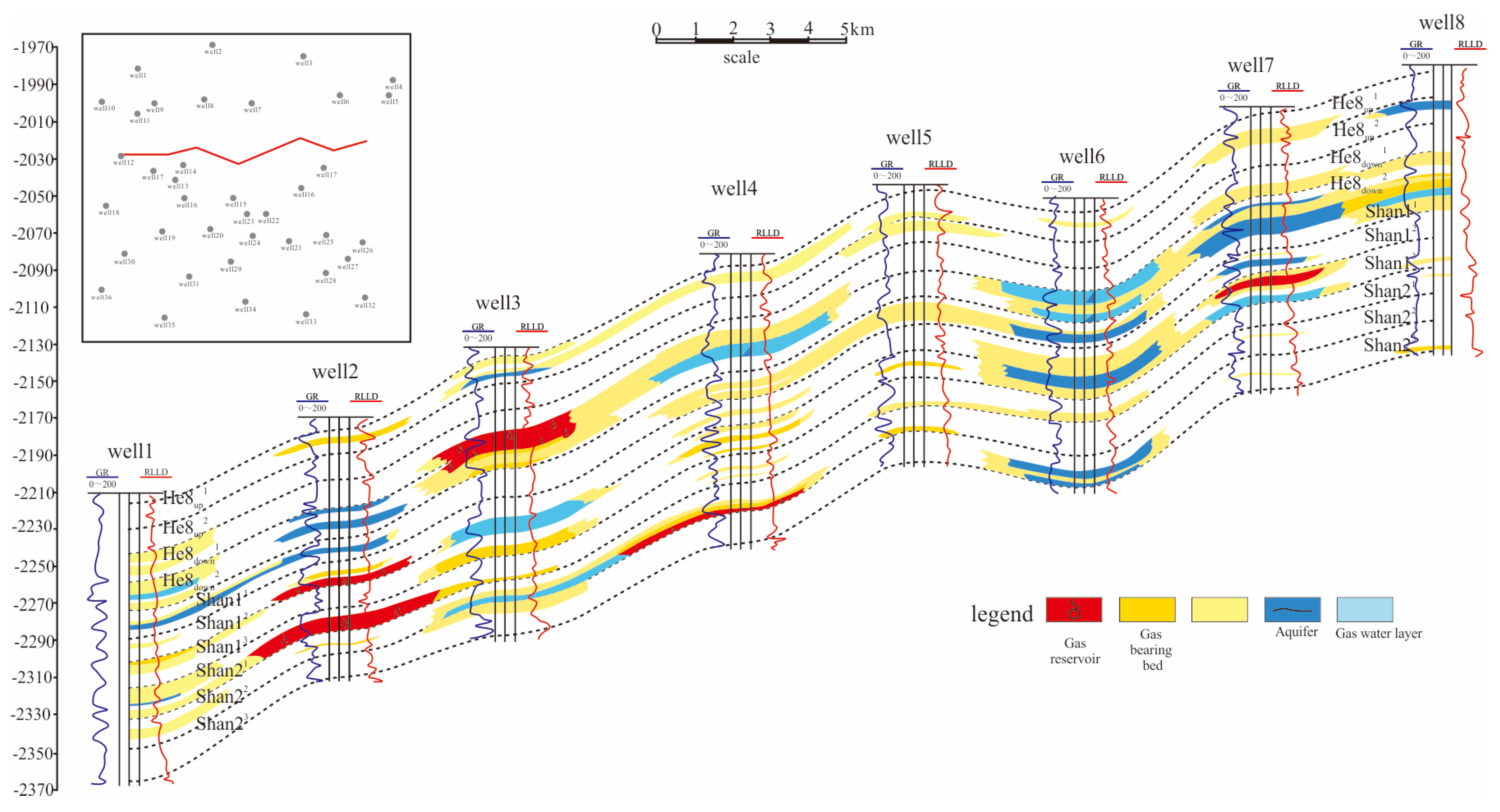
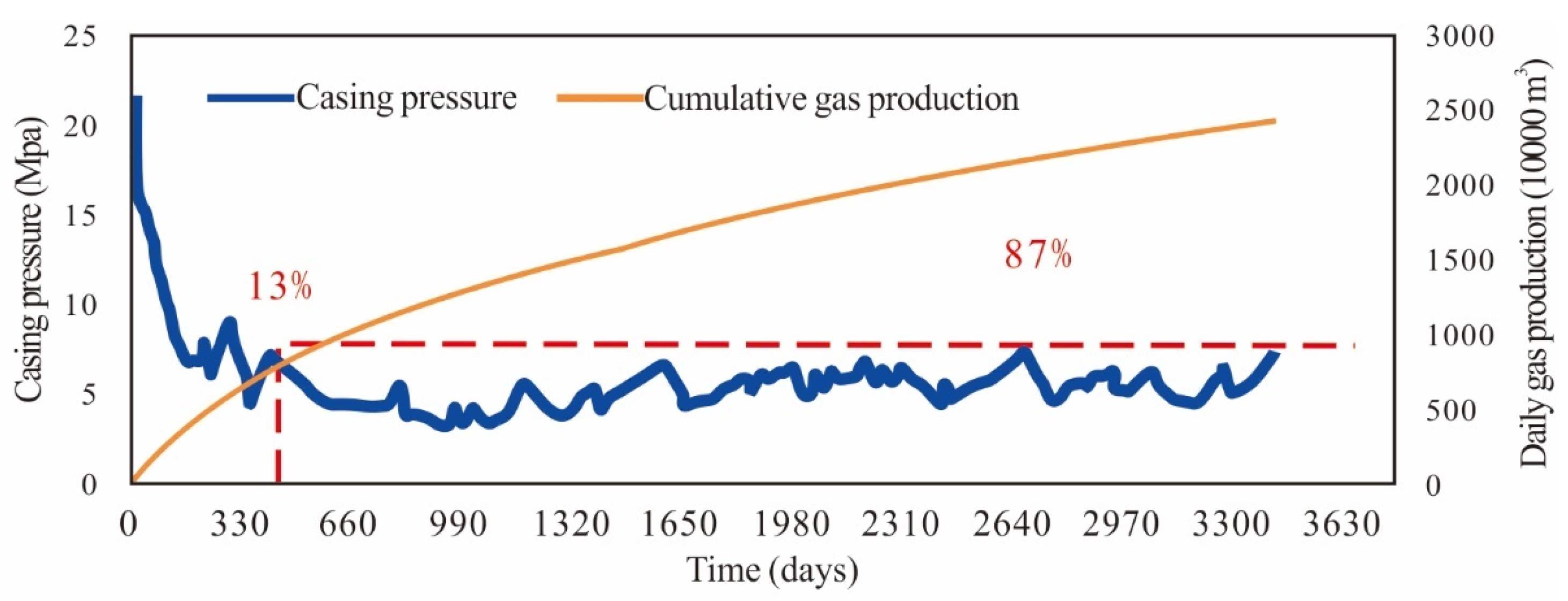
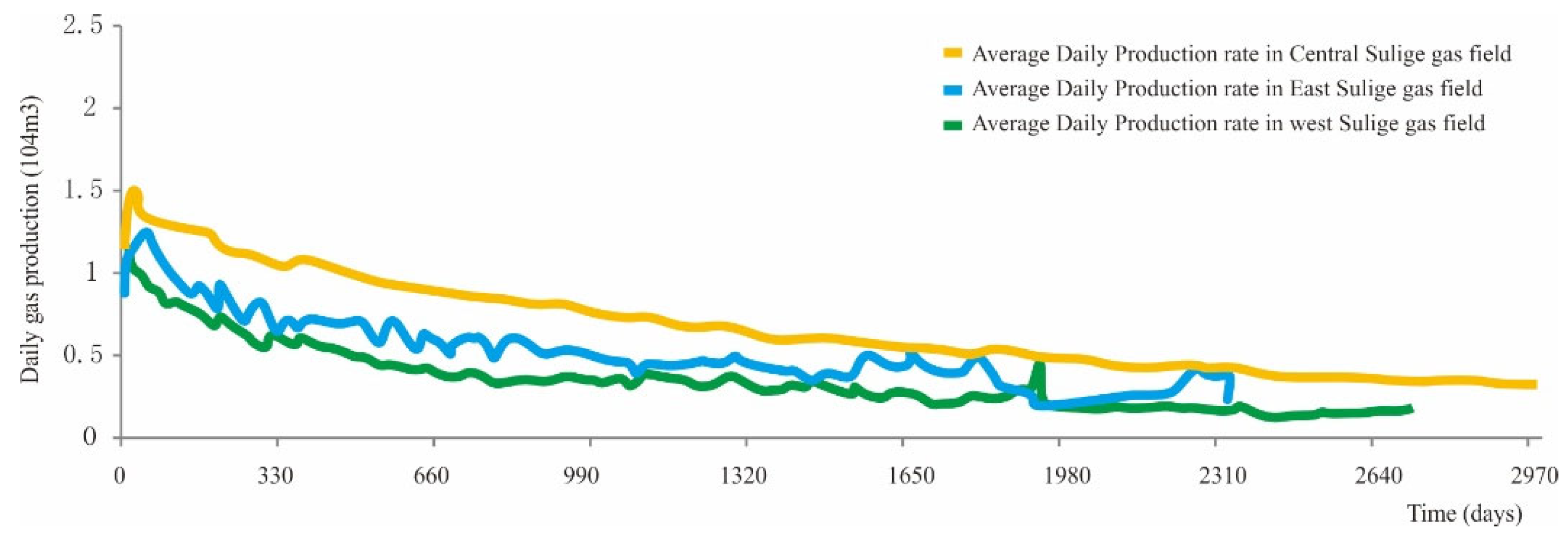
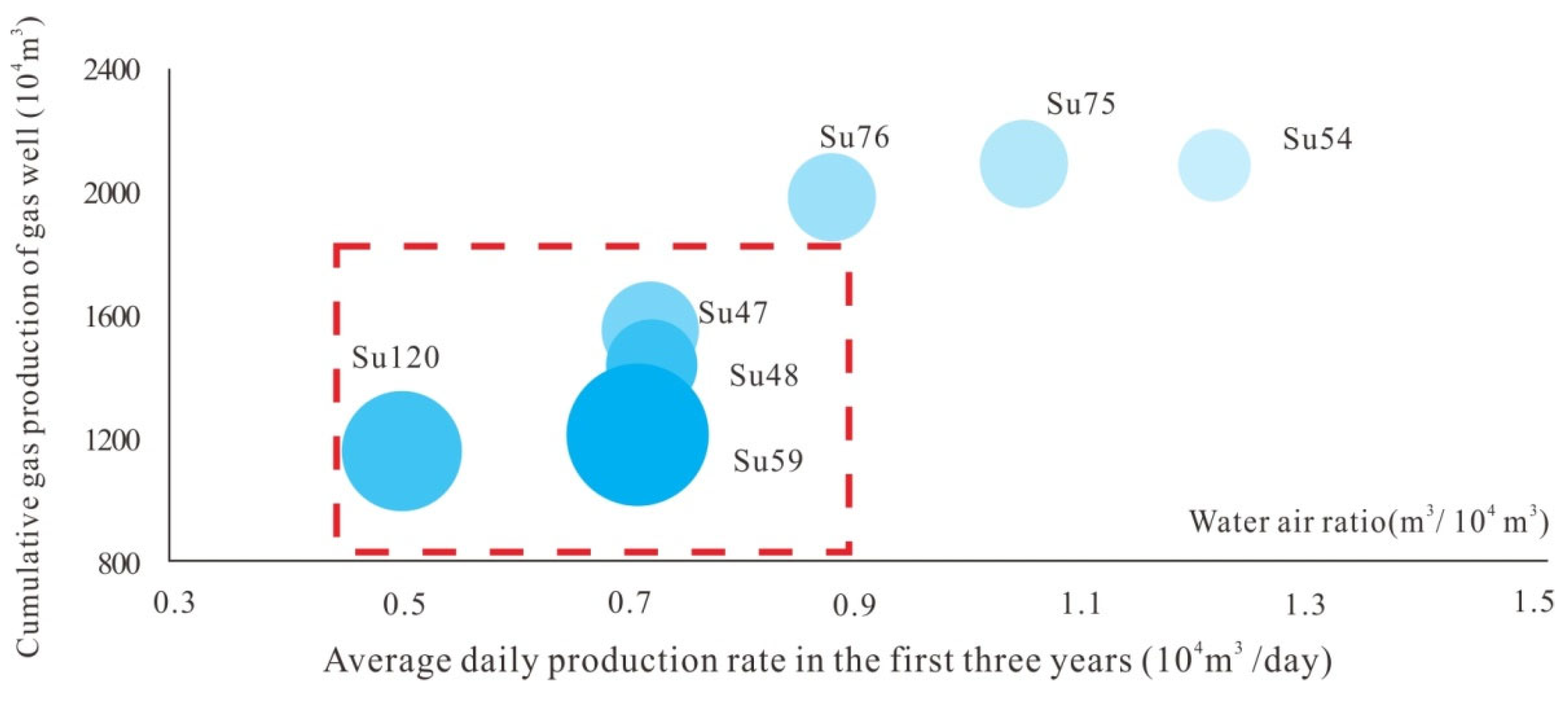
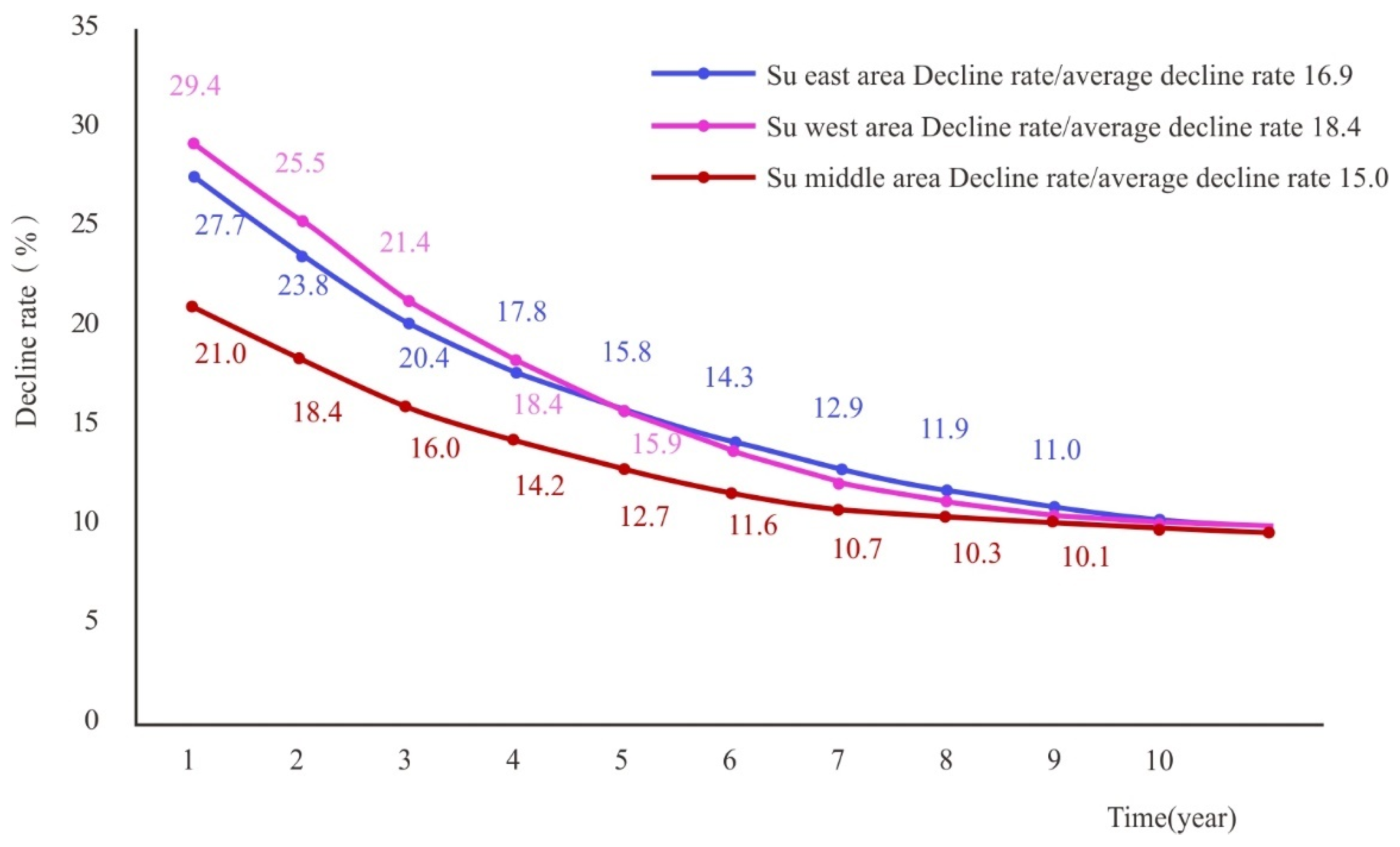

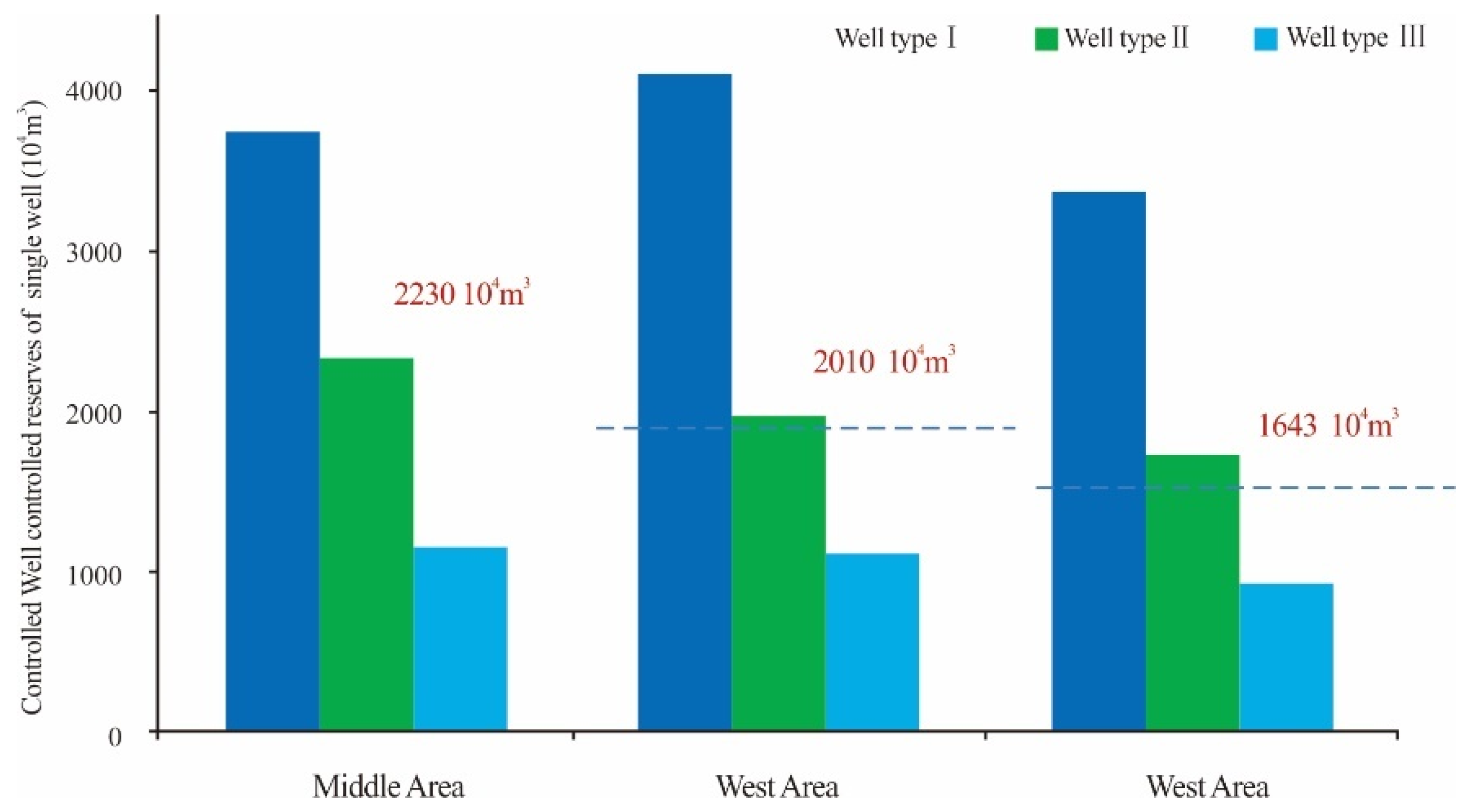
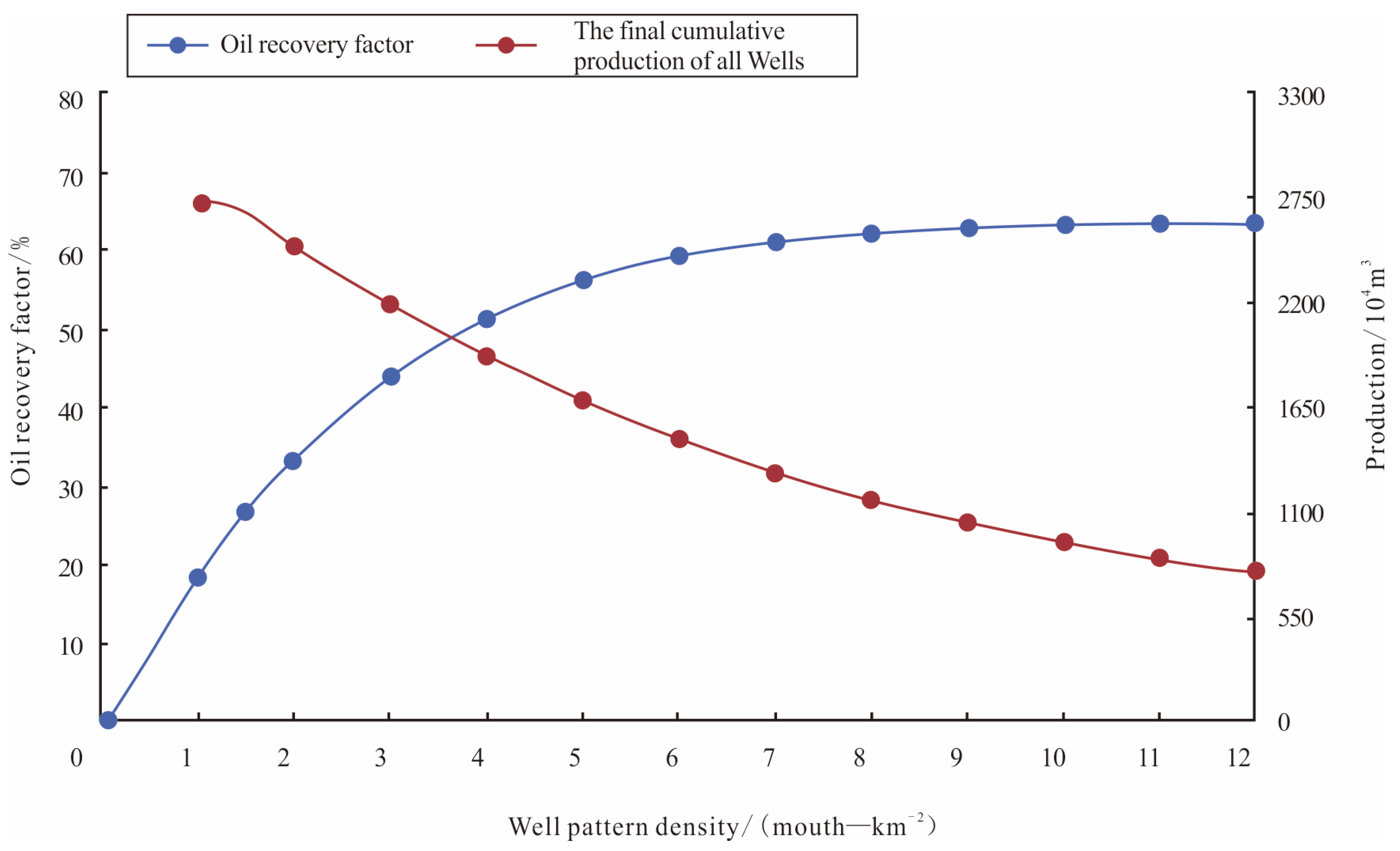
| Region | Permeability (mD) | Permeability Distribution | Porosity | Porosity Distribution | |||||||
|---|---|---|---|---|---|---|---|---|---|---|---|
| Mean | Median | <0.1 mD | 0.1–0.5 mD | 0.5–1 mD | >1 mD | Mean | Median | <5% | 5–10% | >10% | |
| Central | 1.51 | 0.26 | 25.60% | 43.56% | 21.05% | 9.80% | 7.4% | 7.3% | 24.6% | 55.9% | 19.5% |
| Eastern | 0.74 | 0.21 | 26.67% | 52.87% | 10.36% | 10.10% | 8.2% | 7.9% | 21.3% | 48.9% | 29.7% |
| Western | 1.58 | 0.17 | 33.84% | 45.50% | 10.63% | 10.08% | 7.3% | 7.1% | 24.0% | 58.0% | 17.9% |
Disclaimer/Publisher’s Note: The statements, opinions and data contained in all publications are solely those of the individual author(s) and contributor(s) and not of MDPI and/or the editor(s). MDPI and/or the editor(s) disclaim responsibility for any injury to people or property resulting from any ideas, methods, instructions or products referred to in the content. |
© 2023 by the authors. Licensee MDPI, Basel, Switzerland. This article is an open access article distributed under the terms and conditions of the Creative Commons Attribution (CC BY) license (https://creativecommons.org/licenses/by/4.0/).
Share and Cite
Cheng, M.; Xue, W.; Guo, Z.; Hou, M.; Wang, C. Development of Large-Scale Tight Gas Sandstone Reservoirs and Recommendations for Stable Production—The Example of the Sulige Gas Field in the Ordos Basin. Sustainability 2023, 15, 9933. https://doi.org/10.3390/su15139933
Cheng M, Xue W, Guo Z, Hou M, Wang C. Development of Large-Scale Tight Gas Sandstone Reservoirs and Recommendations for Stable Production—The Example of the Sulige Gas Field in the Ordos Basin. Sustainability. 2023; 15(13):9933. https://doi.org/10.3390/su15139933
Chicago/Turabian StyleCheng, Minhua, Wen Xue, Zhi Guo, Meifang Hou, and Chenhui Wang. 2023. "Development of Large-Scale Tight Gas Sandstone Reservoirs and Recommendations for Stable Production—The Example of the Sulige Gas Field in the Ordos Basin" Sustainability 15, no. 13: 9933. https://doi.org/10.3390/su15139933
APA StyleCheng, M., Xue, W., Guo, Z., Hou, M., & Wang, C. (2023). Development of Large-Scale Tight Gas Sandstone Reservoirs and Recommendations for Stable Production—The Example of the Sulige Gas Field in the Ordos Basin. Sustainability, 15(13), 9933. https://doi.org/10.3390/su15139933






